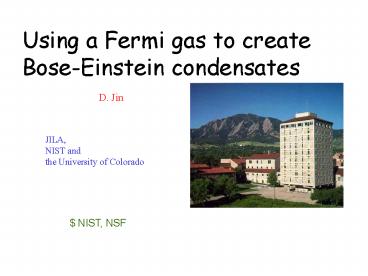Using a Fermi gas to create Bose-Einstein condensates - PowerPoint PPT Presentation
1 / 33
Title: Using a Fermi gas to create Bose-Einstein condensates
1
Using a Fermi gas to create Bose-Einstein
condensates
D. Jin
JILA, NIST and the University of Colorado
NIST, NSF
2
Outline
- Intro and motivation
- A little quantum physics
- Basics of the experiment
- Interactions - An amazing new knob
- Experimental demonstration
- Implications (more motivation)
- Condensates of correlated fermion pairs
3
Outline
- Intro and motivation
- A little quantum physics
- Basics of the experiment
- Interactions - An amazing new knob
- Experimental demonstration
- Implications (more motivation)
- Condensates of correlated fermion pairs
4
Quantum Gases
high T low T
classical behavior
quantum behavior
ldeBroglie d
matter waves
5
Quantum Particles
6
Bosons and Fermions
- half-integer spin
- integer spin
T 0
(two spin states)
other fermions protons, electrons,
neutrons, liquid 3He
other bosons photons, liquid 4He
7
Ultracold atomic gases
- low density
- n 1013 1014 cm-3
- N106
- ultralow T 100 nK
- amenable to theoretical analysis
- unique experimental control
- dramatic detection of condensation
8
Bose-Einstein condensation
BEC shows up in condensed matter, nuclear
physics, elementary particle physics,
astrophysics, and atomic physics.
Cooper pairs of electrons in superconductors
4He atoms in superfluid liquid He
Excitons, biexcitons in semiconductors
Alkali atoms in ultracold atom gases
3He atom pairs in superfluid 3He-A,B
Neutron pairs, proton pairs in nuclei and
neutron stars
Mesons in neutron star matter
9
Condensates with Fermions?
- Condensation requires bosons.
- Material bosons are composite
particles, made up of fermions.
10
Cooling a gas of atoms
300 K to 1 mK ?109 atoms
spin 2
spin 1
11
Cooling a gas of atoms
- can confine any spin-state
- can apply arbitrary B-field
12
Quantum degeneracy
velocity distributions
EF
T/TF0.77 T/TF0.27 T/TF0.11
n0 0.28 n0 0.944 n0 0.99984
Fermi sea of atoms
13
Outline
- Intro and motivation
- A little quantum physics
- Basics of the experiment
- Interactions - An amazing new knob
- Experimental demonstration
- Implications (more motivation)
- Condensates of correlated fermion pairs
14
Interactions
- Interactions are characterized by the
- s-wave scattering length, a
- In an ultracold atomic gas, we can control a!
a gt 0 repulsive, a lt 0 attractive Large a ?
strong interactions
?
0
scattering length
15
Magnetic-field Feshbach resonance
- spectroscopic measurement of the mean-field
energy shift
repulsive
attractive
C. A. Regal and D. S. Jin, PRL 90, 230404 (2003)
16
Magnetic-field Feshbach resonance
V(R)
agt0, repulsive
alt0, attractive
17
Magnetic-field Feshbach resonance
V(R)
agt0, repulsive
alt0, attractive
atoms
? ?
DB
gt
molecules
18
Turning atoms into molecules
Ramp across Feshbach resonance from high to low B
The atoms reappear if we sweep back to high B
- up to 90 conversion to molecules!
19
Bosonic molecules
- molecules are extremely weakly bound !
- molecules can survive many collisions !
Interesting regime
rf photodissociation
C. Regal et al. Nature 424, 47 (2003)
Theory D.S. Petrov et al., cond-mat/0309010,
Expts Rice, ENS, Innsbruck, JILA
20
Making condensates with fermions
- BEC of diatomic molecules
- BCS superconductivity/superfluidity
- Something in between?
1. Bind fermions together. 2. BEC
Condensation of Cooper pairs of atoms
(pairing in momentum space, near the Fermi
surface)
BCS-BEC crossover (generalized Cooper pairs)
21
BCS-BEC landscape
M. Holland et al., PRL 87, 120406 (2001)
BEC
transition temperature
BCS
interactions
energy to break fermion pair
22
Outline
- Intro and motivation
- A little quantum physics
- Basics of the experiment
- Interactions - An amazing new knob
- Experimental demonstration
- Implications (more motivation)
- Condensates of correlated fermion pairs
23
Magnetic-field Feshbach resonance
repulsive
free atoms
DB
gt
attractive
molecules
24
Changing the interaction strength in real time
FAST
repulsive
2 ms/G
DB
gt
attractive
molecules
25
Changing the interaction strength in real time
SLOW
40 ms/G
DB
gt
attractive
molecules
26
Changing the interaction strength in real time
SLOWER
4000 ms/G
DB
gt
attractive
molecules
Cubizolles et al., PRL 91, 240401 (2003) L. Carr
et al., cond-mat/0308306
27
Molecular Condensate
initial T/TF 0.19 0.06
Time of flightabsorption image
M. Greiner, C.A. Regal, and D.S. Jin, Nature 426,
537 (2003).
28
Observing a Fermi condensate
repulsive
40 ms/G
DB
gt
attractive
29
Condensates w/o a two-body bound state
Dissociation of molecules at low density
C. Regal, M. Greiner, and D. S. Jin, PRL 92,
040403 (2004)
DB (gauss)
DB 0.12 G DB 0.25 G
DB0.55 G
T/TF0.08
30
Fermionic condensate
T/TF0.08
? molecules
atoms ?
- Clearly see condensation on the atom-side of
the resonance!
31
BCS-BEC Crossover
? BCS (atoms) BEC
(molecules) ?
C. Regal, M. Greiner, and D. S. Jin, PRL 92,
040403 (2004)
32
Conclusion
- An atomic Fermi gas provides experimental
access to the BCS-BEC crossover region. - Fermi gas ? molecular BEC interconversion has
been explored. - Condensates of correlated fermionic atom pairs
have been achieved ! - generalized Cooper pairs with strong
interactions - Many opportunities for further
experimental and - theoretical work
...
Next
33
Current group members
M. Greiner J. Goldwin S. Inouye C. Regal J.
Smith M. Olsen































